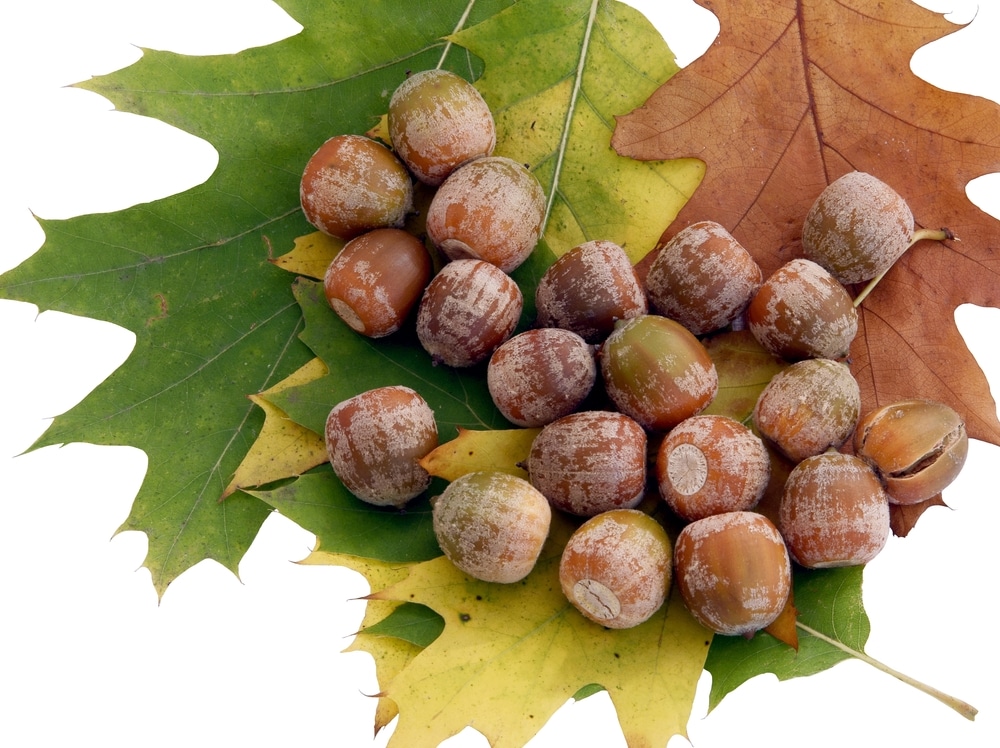Fall is here and although it may seem to be the end of the season for foraging, the warm energy of the summer has been captured in one common, nutritious and fun item to forage: acorns! Of over six hundred species of oak, many produce nuts that have provided a source of protein and fats for people over thousands of years throughout the United States and Canada.
A passionate forager, I recently set out to create acorn-related food products for Edible Wilds, my natural food company in northern Maine, USA that produces food products made from native and wild edible plants.
For any forager the first step is identifying the subject. Of the different varieties of oak trees available, red oak seems to be the most common in my area. The leaves of a red oak tree have lobes that are pointed, and the vein of the leaf comes all of the way out to the edge. Other oaks, such as white oak, have rounded lobes. However, not every oak tree provides the same type of nut.

Acorns contain tannins, which are a class of compounds with a severely bitter taste. Tannins can be toxic to humans, unpleasant to eat, and are poisonous to dogs.
Fortunately, however, the indigenous people of North America had learned that tannins are water-soluble. They would place shelled acorns in baskets and let them sit in fast-flowing rivers for days to “leach” the acorns and remove the tannins. The acorns were then drained and dried for use in various recipes.

After finding a beautiful red oak tree by my public library, I began picking up acorns off the sidewalk. They needed to be whole — acorns that have been bitten by squirrels or that have holes in them will not be fresh or safe to eat.
Unfortunately the acorns of the red oak contain the highest levels of tannins compared to other varieties. However, with patience and a little bit of effort this valuable nut can become a tasty and fun fall project.
The acorns at my library were plentiful and it took me only about twenty minutes to pick up 14 pounds of them! I had timed myself, thinking that acorns might be a new ingredient for an Edible Wilds product.
After collecting the acorns I went back to my shop and began shelling them, crushing the shells with pliers and removing the broken pieces of nut with my fingers. It went more slowly than I had expected, taking about an hour to shell 453 grams (1 pound) of acorns; (I admit I was watching TV while doing so). I weighed the nuts after shelling them and they totaled 284 grams (10 ounces), which means that 170 grams (6 ounces) — more than half of the total — was the weight of the shells themselves.
After finding a beautiful red oak tree by my public library, I began picking up acorns off the sidewalk. They needed to be whole — acorns that have been bitten by squirrels or that have holes in them will not be fresh or safe to eat.
Unfortunately the acorns of the red oak contain the highest levels of tannins compared to other varieties. However, with patience and a little bit of effort this valuable nut can become a tasty and fun fall project.
The acorns at my library were plentiful and it took me only about twenty minutes to pick up 14 pounds of them! I had timed myself, thinking that acorns might be a new ingredient for an Edible Wilds product.
After removing the shells and weighing the nuts came the fun part — leaching.
There are two methods that can be used for leaching. If you don’t live by a fast-flowing river where you can set the acorns in a mesh bag or pillowcase for a few days, you can instead boil the acorns to remove the tannins. This can take a couple of hours if you’re using red oak acorns. Simply place the acorns in a pot with double their volume in water (similar to cooking rice). Bring to a boil over high heat. After ten to twenty minutes you’ll begin to notice the water turning dark reddish-brown, the color of the tannins. Every 20 minutes strain the nuts with a fine-mesh strainer (so as to not lose any of the smaller pieces of acorn) and replace with fresh water. Continue to do so until the water is completely clear — that means the tannins have been removed from the acorns and they are safe to eat.


After the tannins have been removed from the acorns by way of river or boiling, find a nice spot to set them out to dry where animals can’t get to them. Depending on your climate, it may them take a few days to fully dry.
After drying you can use the acorns in many different ways. They can be eaten as is, made into a protein bar, baked into bread, added to pancake batter, and so much more. To make acorn flour, simply place dried acorns into a coffee bean grinder or food processor. I like keeping mine somewhat chunky so I can still experience the consistency of the nut. Below are some traditional recipes that are sure to enlighten your taste buds. ![]()
